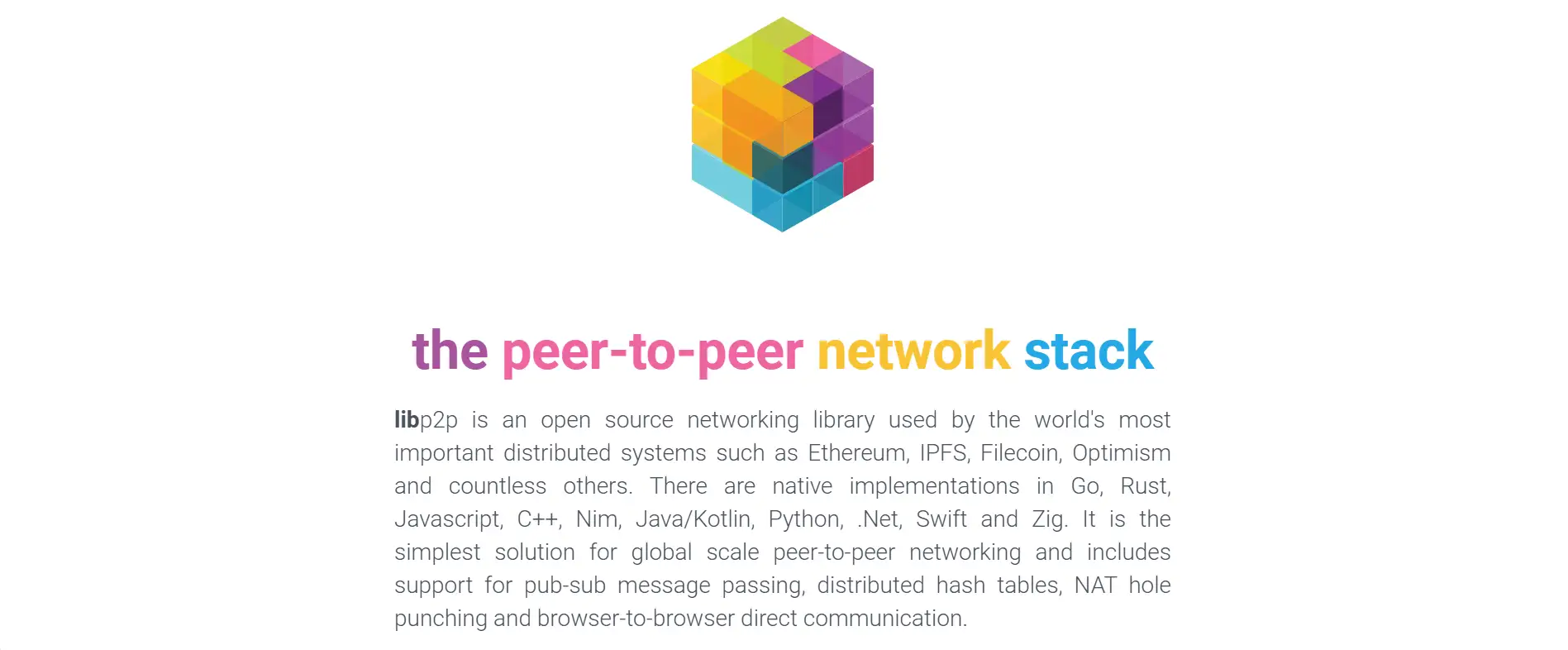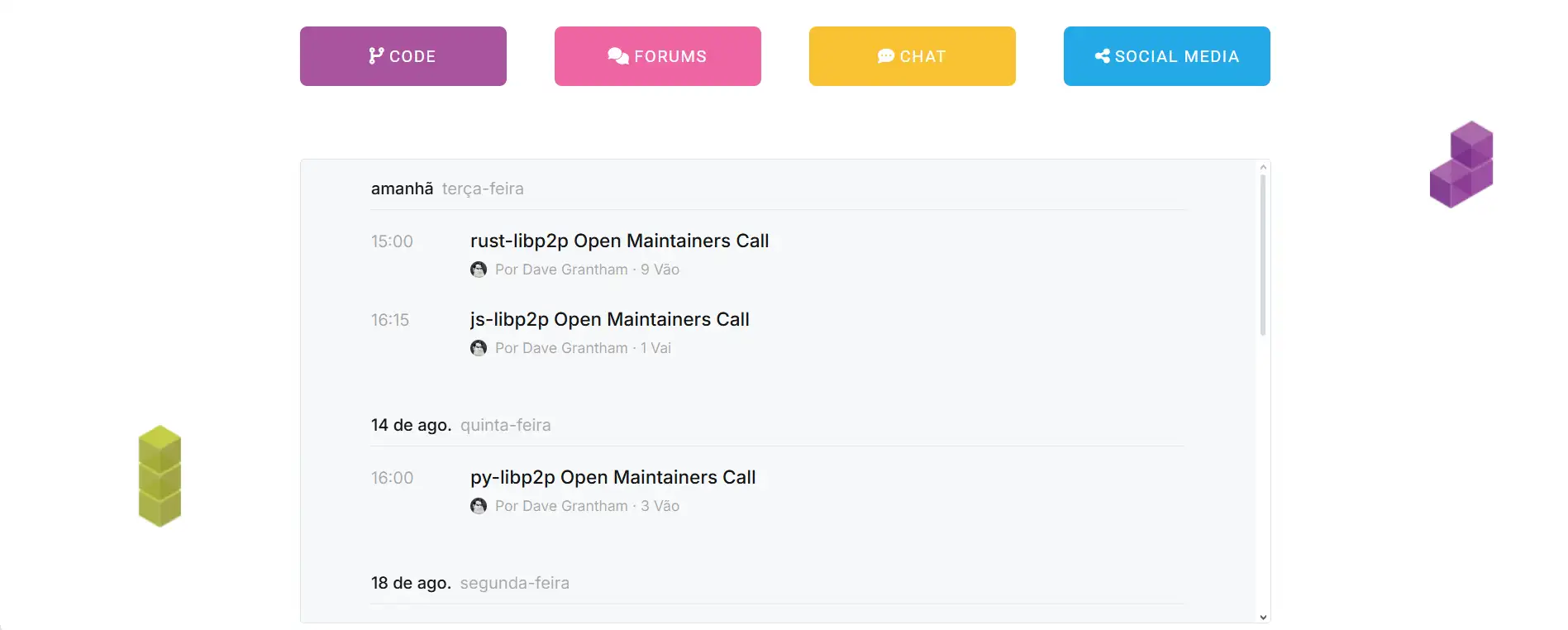About libp2p
libp2p is an open-source modular peer-to-peer networking library powering some of the world’s most important distributed systems, including Ethereum, IPFS, Filecoin, and Optimism. Designed for global-scale connectivity, it provides a versatile set of protocols and tools to connect peers directly, bypassing centralized servers. Developers can integrate libp2p into their applications to enable secure, scalable, and cross-platform networking without reinventing the wheel.
From pub-sub message passing to distributed hash tables, NAT hole punching, and browser-to-browser communication, libp2p provides the building blocks for the modern decentralized web. Its native implementations span multiple languages, including Go, Rust, JavaScript, C++, Nim, Java/Kotlin, Python, .NET, Swift, and Zig, giving developers freedom to work in their preferred environment. With a design rooted in interoperability, libp2p ensures that applications can communicate across diverse networks and platforms seamlessly.
libp2p is not just a single protocol—it’s a modular networking stack that allows developers to assemble only the components they need. It emerged from Protocol Labs as a foundational layer for IPFS and has since grown into an independent, widely adopted toolkit for peer-to-peer systems. Its architecture addresses core networking challenges such as peer discovery, connection security, transport compatibility, and adaptability in varied network conditions. By abstracting these complexities, libp2p enables developers to focus on their application logic instead of network plumbing.
A hallmark feature of libp2p is its transport flexibility. Developers can use modern options like QUIC and WebRTC for low-latency or browser-based applications while retaining compatibility with mature transports like TCP. The system supports multiple simultaneous transports, allowing applications to dynamically choose the most efficient option for a given environment. This adaptability is vital for ensuring reliable communication in high-latency, low-bandwidth, or unstable network scenarios.
libp2p also delivers native roaming capabilities, meaning services can move between networks or machines without manual reconfiguration. Combined with protocol multiplexing, applications can reuse a single secure connection for multiple protocols, reducing overhead and complexity. Additionally, libp2p enables applications to operate offline by discovering peers without centralized registries, further supporting resilience in decentralized environments.
Security is a core principle. All connections in libp2p are encrypted by default, with mechanisms to verify peer identities and prevent eavesdropping. Wire protocol versioning ensures backward compatibility, letting applications upgrade without breaking older clients. The library is open source, actively maintained, and community-driven, with extensive documentation, implementation guides, and language-specific SDKs.
In the broader landscape, libp2p is comparable to but distinct from other networking stacks like WebRTC, Matrix, and Scuttlebutt. While those focus on specific communication models or applications, libp2p offers a general-purpose, protocol-agnostic foundation suitable for nearly any P2P application—from blockchains to distributed file systems, IoT networks, and multiplayer games.
libp2p offers a rich set of features that empower developers to build robust, scalable peer-to-peer applications:
- Multi-Transport Support: Use QUIC, WebRTC, TCP, and more—simultaneously—to match your app’s networking needs.
- Native Roaming: Seamlessly move between networks and machines without reconfiguring connections.
- Runtime Freedom: Assume connectivity regardless of the host platform, from servers to browsers.
- Protocol Multiplexing: Reuse secure connections for multiple protocols, reducing setup time and resource usage.
- Offline Operation: Discover peers without centralized registries for greater resilience.
- Encrypted Connections: Protect data integrity and privacy with built-in cryptographic channels.
- Versioned Upgrades: Update protocols without losing compatibility with older versions.
- Browser Compatibility: Build apps that run directly in browsers with no user installation.
- High-Latency Optimization: Dynamically choose the best transport for slow or unstable networks.
To get started with libp2p and integrate it into your application, follow these steps via libp2p.io:
- 1) Visit the official site: Go to libp2p.io to review documentation, guides, and available SDKs.
- 2) Choose your language implementation: Select from native libraries in Go, Rust, JavaScript, C++, Nim, Java/Kotlin, Python, .NET, Swift, or Zig.
- 3) Install the library: Use your language’s package manager or build from source via the linked repositories.
- 4) Explore the examples: Review code samples to understand transports, peer discovery, and encryption setup.
- 5) Configure transports: Enable and test QUIC, WebRTC, TCP, or combinations based on your use case.
- 6) Implement peer discovery: Use distributed hash tables or local discovery to find and connect to peers.
- 7) Add security: Ensure encrypted connections and peer authentication for all communication.
- 8) Test in varied environments: Verify performance in high-latency, mobile, and offline conditions.
- 9) Join the community: Participate in forums, chat channels, and GitHub discussions linked on the official site.
- 10) Deploy and iterate: Roll out your peer-to-peer application, monitor performance, and update protocols as needed.
libp2p FAQ
libp2p supports multiple network transports—such as QUIC, WebRTC, and TCP—and can dynamically choose the best option for current connectivity conditions. This decision-making happens automatically, so an application running on libp2p.io can move between transports without the user needing to change settings. For example, if QUIC is blocked, the system can fall back to TCP seamlessly, ensuring uninterrupted peer-to-peer communication.
Yes. libp2p supports offline peer discovery without relying on centralized registries. This means peers can locate and communicate with each other over local networks or ad-hoc wireless setups even when no global internet connection exists. Such capability is vital for disaster recovery networks, IoT mesh systems, and offline-first applications.
Protocol multiplexing in libp2p allows multiple application protocols to share the same secure connection. Instead of opening a new handshake and encryption setup for each protocol, all run in-band over one link. This reduces network overhead, improves latency, and lowers resource consumption—critical for blockchains, distributed storage, and real-time P2P applications.
Native roaming in libp2p allows an application or service to move between machines or network environments without losing its peer identity or requiring manual reconfiguration. This is essential for services that must maintain persistent connections—such as distributed ledgers or collaborative apps—across multiple infrastructures or changing network conditions.
libp2p includes support for browser-based execution via transports like WebRTC and WebSockets. Developers can compile their P2P logic into JavaScript or WebAssembly, enabling applications to run entirely in the browser with no installation required. This makes it possible to deploy decentralized chat apps, file sharing tools, or real-time games accessible to users instantly through a URL.
You Might Also Like












